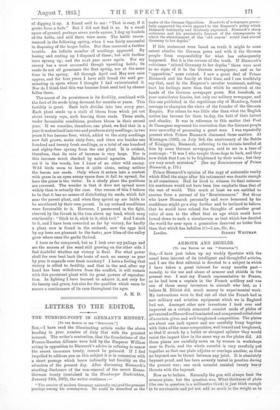ARMOUR AND SHIELDS.
[To THE EDITOR or THE " SPECTATOR.") have just taken up my weekly Spectator with the usual keen interest of its intelligent and thoughtful articles. and I see the first editorial is devoted to a subject in which I have taken a great interest for many months past— namely, to the use and abuse of armour and shields in the present war. I sent my French representative to France as he had been a captain in the French artillery and was one of those many inventors in aircraft who lost, as I believe M. Bleriot did, much money in experimental work. My instructions were to find out all that the French had in new military and aviation equipment which we in England had not. Amongst other new inventions I took over and improved on a certain armoured corselet made of plates of galvanized or Sherardi zed laminated and compressed rolled steel of a certain given and well-toughened composition. The plates are about 'one inch square and are carefully hung together with links of the same composition, well brazed and toughened. so that if struck by a bullet or shrapnel splinter they would resist the impact blow in the same way as the plates did. All these plates are carefully sewn on by women in workshops near to Paris, and the whole corselet is very carefully put together so that one plate adjoins or overlaps another, so that no bayonet can be thrust between any joint. It is absolutely bayonet proof, and has been severely tested in practice during the present wars one such corselet resisted twenty heavy thrusts with the bayonet.
Now as to bullets. Naturally the gun will always beat the armour-plate, but the question was, What thickness of plate (the one in question is a millimetre thick) is just thick enough to be serviceable and yet not add so much to the weight as to be too heavy for infantry work in the trenches P We found this was the limit, and that if all these plates were hung on khaki cloth of a given toughness, and hung together over the shoulders with easily detached buttons, such as are put on gloves, the whole weight was thus evenly distributed back and frOnt over the body and protected all the vital parts.
Now another point was carefully thought out, namely, if a bullet struck a plate would it expand, and we found it did not; also would it splinter the plate? Yes, it does when hit at very short range. It falls into fine dust like so much pulverized glass, and the bullet travels to its destination directly, just as if there had been no plate there. At longer ranges of several hundred yards, when struck by a bullet, the metal of the particular plate struck bends, curving inwards, and could not do more than scratch the flesh or tear the clothing, and if by any chance a piece should be broken off and carried into the body, then, as such piece is Sherardized or galvanized, no septic or poisoning influence ensues, and the piece should be easily extracted by the magnet or forceps.
The whole corselet weighs five pounds, but if the front, which is easily and quickly detached from the back part, is only used then the weight is only three pounds! I have sent many of these corselets to officers at the front, and they write me letters highly approving of it. I showed it at the War Office, with the usual result of indifference, and also at the Admiralty, who thought highly of it, but did not see its application to naval purposes; perhaps later they may also think differently.
I also received from France a thoroughly ,bullet-proof screen, one of which has saved the life of many a great French general. This screen, when fired at with the most modern gun, resists penetration, the bullet being split or falling harmlessly to the ground. This screen can also be fitted on to the head, and will protect men who unwisely look above the parapet. Both these also were sent to the War Office and returned with indifference. I have since fought an uphill battle, but am gradually winning against trenches of ignorance and prejudice, and shall finally be victorious. This is always the fate of inventors, but some who come to scoff remain to pray.—I am, Sir, &o.,
EDGAR P. RATREONE,
Late Government Inspector of Nines and Explosives, B.A.
[We publish this letter owing to the interest of the subject, but must entirely dissociate ourselves from the attack on the War Office for "indifference" to practical suggestions. We can only say that our experience is exactly the reverse of Mr. Rathbone's. We have found the military authorities not only willing but alert to consider all reasonable sug- gestions.—En. Spectator.]



































 Previous page
Previous page